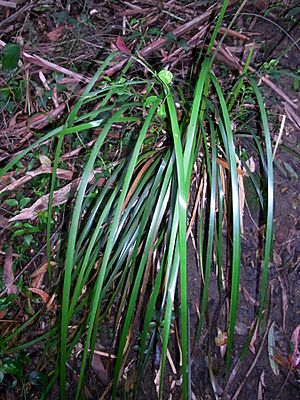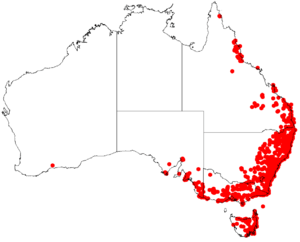Variable swordsedge facts for kids
Lepidosperma laterale, also known as the variable swordsedge, is a type of plant found in south-eastern Australia, New Caledonia, and New Zealand. It often grows in sandy soil or rocky areas within forests and woodlands.
Quick facts for kids Variable swordsedge |
|
|---|---|
 |
|
| Growing in rainforest at Chatswood West, Australia | |
| Scientific classification | |
| Genus: |
Lepidosperma
|
| Species: |
laterale
|
 |
|
| Occurrence data from AVH | |
| Synonyms | |
Contents
What is the Variable Swordsedge?
The name laterale comes from a Latin word meaning "sides." This plant can look a bit different depending on where it grows. Scientists have not yet officially divided it into different types. The variable swordsedge was first described in science in 1810. This was done by a famous Scottish botanist named Robert Brown. He wrote about it in his book, Prodromus Florae Novae Hollandiae.
What Does the Variable Swordsedge Look Like?
This plant can grow up to one metre (about 3 feet) tall. Its leaves are often shiny and can be between 3 to 8 millimetres wide. The bottom part of the leaf is usually orange-red.
The flowers of the variable swordsedge grow in a special cluster called a panicle. They appear in spring and summer. The flower clusters are not very dense, so you can see the smaller branches of the inflorescence (flower arrangement). These branches can be from 4 to 20 centimetres long, and sometimes even up to 38 centimetres.
After flowering, the plant produces a fruit. This fruit is a small, oval-shaped nut. It is about 3 millimetres long and 1.8 millimetres wide. The nut can be light or dark brown. Its surface can be wrinkled or smooth and shiny.
Where Does the Variable Swordsedge Grow?
The variable swordsedge is found in many different places. However, it does not grow in the very dry parts of Australia. You can find it across central and eastern New South Wales, reaching as far west as Lockhart.
In Tasmania, this plant is part of two special plant communities. These communities grow near rivers. They are made up of ferns, sedges, and heath plants. In one community, you will find many Melaleuca squarrosa and Leptospermum lanigerum trees. In the other, you will see Eucalyptus viminalis, E. globulus, E. obliqua, and E. amygdalina trees. Smaller plants like Beyeria viscosa and Exocarpos cupressiformis grow underneath them.
Who Eats the Variable Swordsedge?
Many types of moths from the genus Elachista lay their eggs on the variable swordsedge. When the eggs hatch, the caterpillars eat the leaves of the plant. This shows how different living things depend on each other in nature.

